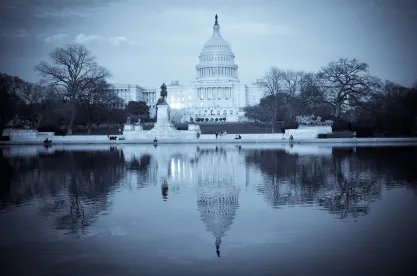Joseph R. Biden Jr.’s inauguration on January 20, 2021 as the forty-sixth President of the United States could usher in a sweeping period of environmental regulatory changes vastly eclipsing those of his immediate predecessor – and perhaps even those of President Barack Obama. Further, with key Senate victories in January by Jon Ossoff and Raphael Warnock in Georgia, a Democrat-controlled Congress is better situated to help the President-elect achieve the environmental goals he’s promised would be a focus of his administration.
Regulated industries can expect the new administration to consider action on climate change, environmental justice, chemicals regulation, wetlands/waters of the United States, and endangered & threatened species. Although some of these actions may be complex, look for key Trump administration rules to be rolled back and replaced and new rules and legislation to be proposed. Below we provide a brief overview of key environmental policy initiatives poised for action under a Biden administration:
“Re-regulatory” actions
-
Repeal and replacement of Executive Orders: The Trump administration issued numerous Executive Orders aimed at reducing regulatory burdens which now face possible repeal and replacement by the Biden administration. Chief among these is EO 13771, which mandated the repeal of two existing regulations for each new one issued by a federal agency. Other potential targets for reversal include EO 13783 (which resulted in the replacement of the Clean Power Plan with the Affordable Clean Energy Rule), and EO 13891 (which generated an EPA final rule that, among other things, establishes a petition process for public requests to modify or withdraw agency guidance).
-
EPA rules – withdrawn or repealed/replaced:
-
Numerous final rules promulgated by EPA under the Trump administration (and widely seen as industry-friendly) now could be withdrawn or repealed and replaced under the Biden administration. Potential targets include rules promulgated under the Clean Air Act (CAA) (the Cross-State Air Pollution Rule Update Remand for 2008 Ozone NAAQS, Cost-Benefit Analysis Revision; NSPS for GHG Emissions from New, Modified, and Reconstructed Electric Utility Generating Units); Reclassification of Major Sources as Area Sources Under Section 112 of the Clean Air Act (the so-called “once in, always in” rule); the Endangered Species Act (ESA) (regulations governing critical habitat designations); Federal Insecticide, Fungicide, and Rodenticide Act (chlorpyrifos risk assessment); Resource Conservation and Recovery Act (RCRA) (coal combustion residuals permit program); Toxic Substances Control Act (TSCA) (persistent, bioaccumulative, and toxic substances); and the EPA’s controversial rule regarding the transparency of scientific data underlying regulatory actions.
-
As an alternative to agency action, which may take some time, Congress could use the Congressional Review Act to overturn some of the regulations noted above. The CRA provides for a fast-track process that only requires a majority vote to repeal a rule, but only applies to rules that were finalized by the executive branch in the previous 60 legislative days.
-
Environmental Justice
We expect the Biden administration will revive and strengthen efforts to infuse the concept of “environmental justice” across federal agencies, but particularly the EPA. Michael Regan, Biden’s nominee to lead EPA, created an Environmental Justice and Equity Board during his time as Secretary of the North Carolina Department of Environmental Quality, which (among other things) created a community mapping system that the NCDEQ uses to inform agency decisions by considering demographic and health information – and which could serve as a model for EPA decision-making.
Relatedly, the Biden administration may withdraw the Department of Justice’s current prohibition on Supplemental Environmental Projects (“SEPs”) – voluntary projects with environmental or public health benefits which were previously used as a component of enforcement settlement actions. Nixed by the Trump DOJ due to administrative cost concerns, the Obama-led DOJ considered SEPs to be a valuable compliance tool, because they often have a public accountability component (e.g., installation of air monitors near a school, with results made available to the public). We expect to see SEPs return as a component of EPA settlements in 2021.
PFAS
Under the Trump Administration, the EPA took initial steps toward regulating the class of emerging chemicals referred to as per- or polyfluoroalkyl substances (or “PFAS”), creating a “PFAS Action Plan” that EPA was then criticized for not implementing fast enough. Meanwhile, states have moved with varying speed to promulgate binding standards for certain PFAS, creating a regulatory patchwork.
We expect federal regulatory efforts will move more swiftly under the Biden administration. Key among EPA’s expected efforts may be the listing of certain PFAS as “hazardous substances” under CERCLA, thereby establishing a mechanism for private parties to recoup cleanup costs and provide for EPA oversight through CERCLA. EPA will likely also move more swiftly to promulgate Safe Drinking Water Act standards for key PFAS, as well as using its authority under TSCA to obtain additional information about possible PFAS sources and considering potential additional use restrictions.
CAA and Climate Policy
-
Vehicle Fuel Efficiency Standards: The Trump administration’s Clean Air Act deregulatory efforts included a revocation of the act’s preemption waiver, which had previously allowed states – particularly California – to promulgate stricter fuel economy standards and reductions in Obama-era fuel efficiency targets. The rule had been challenged by California, and we expect the Biden administration will abandon its defense of the preemption rule and propose regulatory changes to bring fuel efficiency standards back closer to Obama-era levels.
-
Focus on renewable energy alternatives: On the campaign trail, candidate Biden pledged a $2 trillion commitment to a “Clean Energy Revolution.” President-elect Biden’s picks for key cabinet posts – including Jennifer Granholm (as Secretary of Energy), Gina McCarthy (as head of a new White House Office of Domestic Climate Policy), John Kerry (as a special envoy for climate within the National Security Council), and Deb Haaland (as Secretary of Interior) – indicates an intent to make good on these campaign promises. With key Democratic Senate victories in Georgia, we expect Biden and his climate team to advance electric vehicle and “smart grid” technology, scaling up federal tax credits for renewable energy sources (such as solar and wind) and additional legislative limits on carbon emissions.
FIFRA
The ongoing COVID-19 pandemic has been a stress test for EPA’s approval process for pesticides and pesticide devices pursuant to FIFRA, as manufacturers rushed to market cleaning and disinfecting products with COVID-effectiveness claims. In early 2020, EPA established a protocol for products already FIFRA-approved to make COVID-19 claims, and the agency subsequently expedited its review of emerging viral pathogen claims by approved process. Nonetheless, manufacturers of pesticides and pesticide devices have expressed frustration about EPA’s timeline for FIFRA approvals. At the same time, EPA has not relaxed its enforcement efforts against products that violate FIFRA.
This regulatory logjam presents a potential opportunity for new FIFRA rulemaking to streamline approval efforts – perhaps in the mold of FDA’s approach to consumer hand sanitizers – although EPA has not proposed anything concrete at this time. Meanwhile, we expect EPA’s heightened enforcement efforts to continue at least through 2021, as the pandemic continues.
Wetlands/Waters of the United States
-
Abandonment of WOTUS rule defense: In April 2020, U.S. EPA finalized its Navigable Waters Protection Rule, which streamlines the definition of “waters of the United States” under the Clean Water Act into relatively clear categories of jurisdictional waters and provides exclusions for certain water features. The rule was immediately challenged in court, and it is possible that DOJ will abandon its defense of the rule under a Biden administration. It is also likely that the agency will consider rulemaking to bring the definition back in line with the Obama-era rule that had been repealed during the Trump administration.
-
Revision/rescission of draft County of Maui guidance: In 2020, the Supreme Court addressed the question of whether non-direct point source discharges into navigable waters require a permit under the CWA. The Court’s answer – provided in County of Maui v. Hawaii Wildlife Fund, 590 U.S. ___, 140 S. Ct. 1462 (2020) – is yes, if the discharge is the “functional equivalent” of a direct discharge from a point source to navigable waters. In December 2020, EPA published draft guidance that reads the County of Maui decision narrowly and adds an additional “functional equivalent” factor to the Court’s multifactor test. We expect this guidance will be withdrawn or substantially revised under a Biden EPA. It remains to be seen whether the agency will take steps to otherwise codify the County of Maui decision or merely look to it for purposes of permitting and enforcement.
TSCA
-
Risk evaluations and management: The EPA continued to make progress on its required risk evaluations under the Lautenberg Amendments to TSCA during the Trump administration, and is expected to continue its efforts in a timely fashion. At the time of publication, 9 of 10 risk evaluations required to have been completed by the end of 2020 had been finalized by the agency. Draft risk management plans for these ten chemicals are required to be finalized by EPA by the end of 2021.
-
TSCA fees rule: In December 2020, EPA released proposed revisions to the Fees for the Administration of the TSCA Rule, which governs EPA’s ability to recover fees incurred from the TSCA risk evaluation process. The proposed revisions narrow the scope of the original 2018 fees rule by reducing the scope of parties from which the fees may be recovered, including from parties who use de minimis amounts of those chemicals or where the chemicals that are the subject of the risk evaluation are present in an article. We anticipate that this rule is likely to continue to proceed with no or only minor changes from the new administration. EPA’s comment period for the revised rule will remain open until February 4, 2021.
ESG
-
Disclosure of environmental, social, and governance (ESG) information has for some time been a voluntary, market-driven process led by investors and shareholders. With the Biden Administration focus on climate change, we expect to see rules on mandatory ESG disclosures and climate risk reporting. For example, legislation similar to that proposed by Senator Elizabeth Warren in 2019 – which directed the Securities and Exchange Commission to require companies to annually disclose climate change-related risks to their shareholders – may find new favor in a Democrat-controlled Congress and Executive Branch.






 />i
/>i
